How to talk for free about your startup in foreign media with a million audience: difficulties and ways to circumvent them

Millions of businessmen all over the world dream that the leading English-language publications write about their project. Today I will talk about the difficulties that may arise in trying to realize this desire, and how to get around them.
"Need to get into TechCrunch": the complexity of working with top media
So, you have a business that you want to talk about on the pages of foreign online media. And not anyhow anyhow, but large and well-known to the whole world - from Mashable to VentureBeat, while the project is not yet so cool as to foreign media. Let's talk about how you can get to their pages.
')
The first option is to offer them some interesting infopovod related to the project. This path is well described in the already classic article VC.ru - the iblazr startup team (flash for smartphones) was able to get into the top media, like TechCrunch - the launch of the project on KickStarter became the information guide. At the same time, it is important to understand that the editors themselves did not take it and became interested - it took a lot of time and effort to attract attention: the project team analyzed the interests of the authors of popular media and blogs, offering its press release to those whom it could interest, several hundred were sent. letters.
In the case of iblazr, this worked, but it is obvious that not every startup can boast of any news that goes beyond its usual activities - which means that even a thousand of sent letters will not help to attract media attention. In this case, it remains to share your expert knowledge in the format of columns - this is a very popular genre, not only in Russian, but also in foreign media. But this does not mean that publishing your column will be easy.
It is important to understand that editors of any more or less well-known media are simply attacked by startupers and PR people from all over the world. The volume of incoming calls from them just rolls over, so often they simply do not respond to emails. When contacting general editorial addresses like
info@site.com or editorial@site.com , it’s almost impossible to wait for an answer, which means you need to somehow find a direct contact to the editor - there are even special services ( one , two ) that are for money help solve this problem.In this case, if you still answered, then with a high degree of probability it will only be a notification of receipt of the material. For example, this summer I wrote a material on how artificial intelligence could improve email in its current form, and offered the text to one of the leading online media on The Next Web technologies. The answer that my text was received and will be answered later came on August 21:

After some time, the editor wrote to me that for a number of reasons the material does not fit. And all would be fine, but his answer came already on October 4, that is, almost a month and a half after sending the material:

Wait a month and a half for the reaction to find out that your material will not be taken! It is important to say that in fact, this is still a very good option, since in this case the editor at least indicated the reasons for the refusal. Such a detailed review is a rarity, usually media representatives either answer nothing at all, or they get off with standard phrases that they cannot give detailed feedback due to the large number of incoming texts.
Another important point is that even if you manage to place one article in the top-end media, this will not facilitate the process of subsequent publications. For example, I managed to publish my research in The Next Web , but several subsequent, and as it seemed to me, even more interesting materials, the editors "turned."
Due to the fact that editors of well-known media organizations have to work at a frantic pace, responding to dozens of letters a day, communications may arise. For example, once I offered my material about one of my projects (chat bot for marketers) to VentureBeat, and the journalist liked it. He asked me to send a photo for the avatar through the Gravatar system, I was not registered there, and while I understood, it turned out that the article had already been published . And my profile turned out to be without an avatar, and there was no time for the editor to respond to my subsequent letters asking to install it. Nothing terrible has happened, but the moment is indicative - if suddenly some kind of mistake sneaks into the material, and it must be corrected after publication, it may not be easy.
At the same time, to circumvent all the described difficulties at the expense of money is also not so simple - native advertising in top online media is very expensive. Price lists of the publication are usually not published, but with the help of intermediary websites to automate the purchase of the “native”, you can find out, for example, that the cost of the post on The Next Web will be more than 780 thousand rubles:
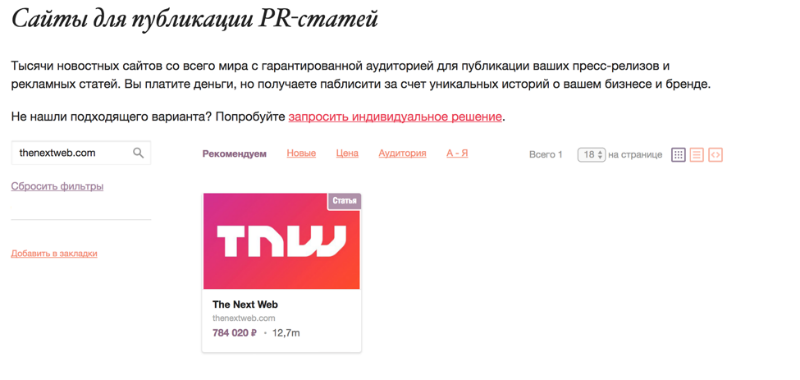
If there is no budget and time: we work with Medium
Most startups do not have budgets that would allow them to regularly publish in the top media on a fee basis. In addition, often native advertising with the appropriate mark just does not fit into the marketing strategy - it may be important for companies to show that they write about it and not only for money. At the same time, a rare startup can afford and wait for a half or two months to respond to the letter only for one article. If publication is planned in support of a specific event (yes the same ICO!), Then after such a long time it may simply not be necessary.
At first glance, the situation looks rather sad - it is not clear how to promote a project abroad in such harsh conditions. But not everything is so bad, and there are acceptable alternatives to trying to get into TechCrunch. The most important of them is the blog platform Medium.
In RuNet, this service does not enjoy serious popularity, but in the English-speaking world it is one of the main media platforms. It allows you not only to keep personal blogs, but also to launch your own media. There are a lot of such publications - on Medium - they are called “publications”, among them there are very popular ones with millions of readers and hundreds of thousands of subscribers in various social networks. A list of the most popular publications, broken down by category, can be found on the Toppub website, this is how the top 5 Medium-based media looks like now:
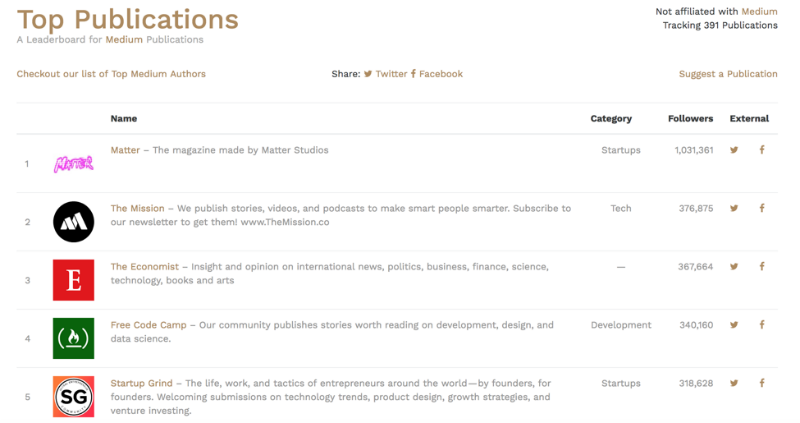
Publications on Medium can belong to some company, or they can develop according to the model of the media - and in such cases, their editors can offer their materials as guest posts. It is quite simple to do this: usually publications that accept columns by external authors select the button directly in the menu for instructions on how to send materials. It looks like this (button Submit):
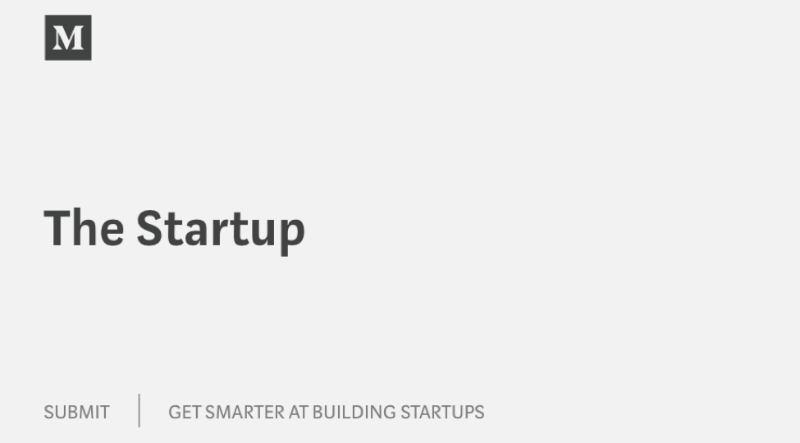
Information about what publications are looking for external authors is also presented on the Smedian project website :
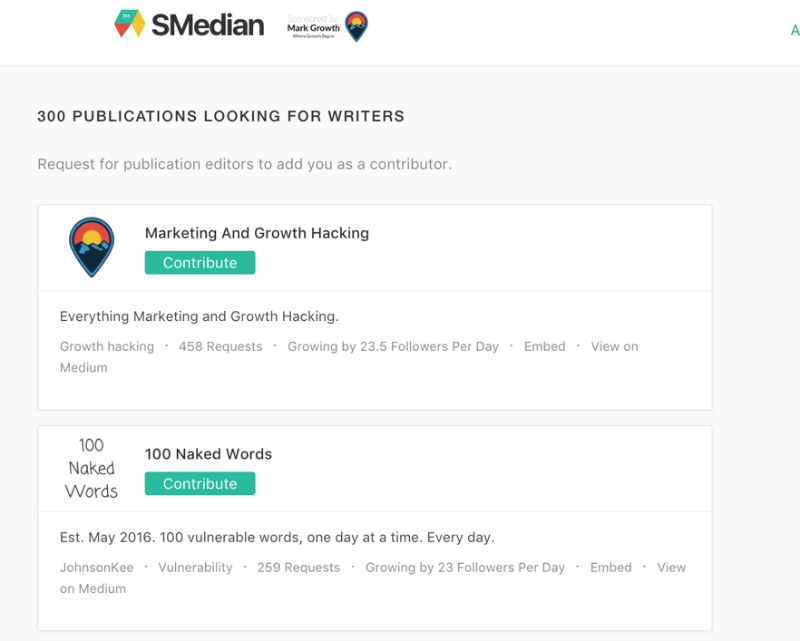
To send a request to join a publication as a blog, you need to log in to your Medium profile and click the Contribute button - the media editors will review the publications in the profile and add you as an author. After that, you can send your columns directly through Medium - after typing the text, you can add it to a specific publication, the administrators of which will then publish it:
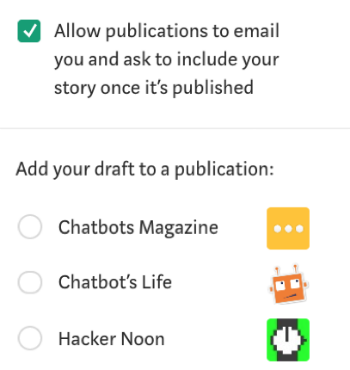
This is how the menu looks like adding a post to a specific post.
All this is very simple, while the editors of the media on the Medium platform are much quicker and more loyal than their counterparts from the traditional business media that everyone is used to. In my case, the material that was never published on The Next Web, and the answer I was waiting for a month and a half was published in the Hackernoon tehnoblog for a day.
One might think that everything is so simple because no one reads such media or blogs, but this is not so. For example, the mentioned Hackernoon overtakes such a famous edition as VentureBeat by the number of readers, and this blog just balances on the border of the top 10 publications in Medium - there are much more popular publications:
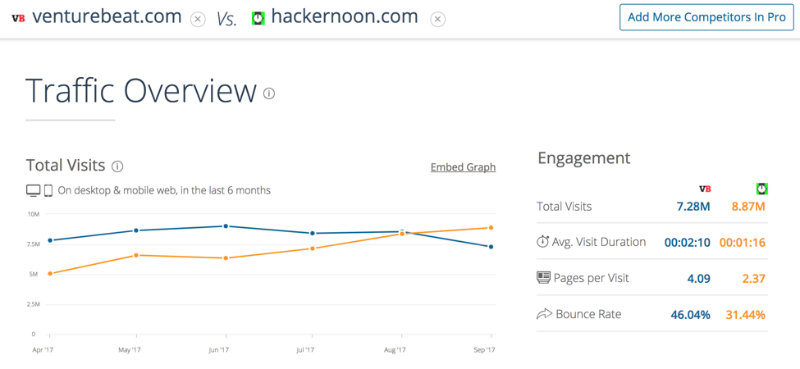
Recently, I sent material with a story about my business experience to VentureBeat - they didn’t take it there, but in the same Hackernoon it was released in a day, and I didn’t lose anything in readability.
Summary
The sphere of online media is constantly evolving, and this gives the founders of startups new opportunities to promote in new markets. Previously, to get coverage of an English-speaking audience, a new project needed to go to TechCrunch pages and spend a lot of time, effort, or money. Today, new platforms, like Medium, contribute to the emergence of popular online media of a new format, the editors of which are much more loyal to external authors.
I felt this progress in my company - if before we had to wait for a response to the articles sent to the editorial staff for a month and a half, now for the same time we manage to post 5-6 media materials with millions of reach. It suits us well.
Source: https://habr.com/ru/post/341846/
All Articles